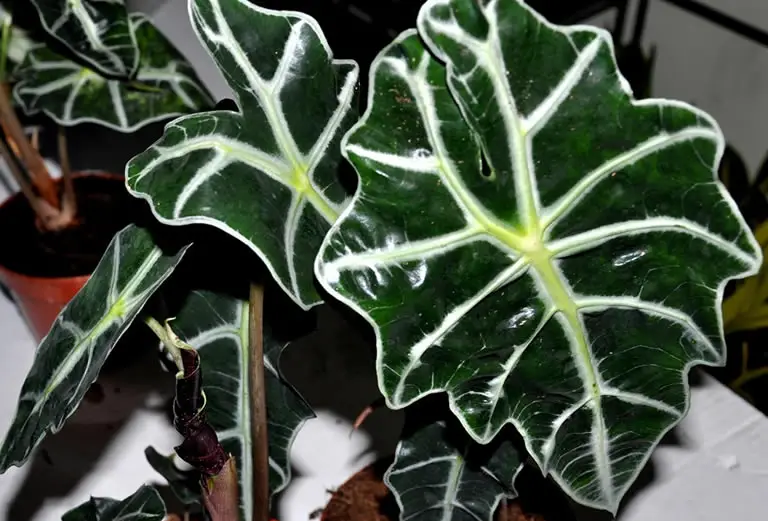Alocasia Amazonica, often lovingly called Alocasia Polly, is all about the drama—thanks to its bold, tropical leaves that look like they’ve been hand-painted. If you can provide the right conditions, this hybrid beauty will reward you with stunning foliage year-round.
Table of Contents
- Lush Leaves & Easy Vibes: A Friendly Guide to Alocasia Amazonica (AKA Alocasia Polly)
- A Closer Look at Its Origins
- Standout Features of Alocasia Amazonica
- Best Soil for Happy Roots
- Light Preferences: Bright, But Not Harsh
- Keep It Cozy: Ideal Temperature Range
- Watering Routine: Keep It Moist, Not Wet
- Boosting Humidity for a Tropical Vibe
- Feeding Time: What Fertilizer to Use
- Do You Need to Prune?
- When (and How) to Repot
- Propagating Your Alocasia
- How to Keep Those Gorgeous Leaves Clean
- Watch for These Common Problems
- Troubleshooting Yellow, Brown, or Droopy Leaves
- Dormancy and Regrowth
- How Big Will It Get?
- Is It Safe for Pets or Kids?
Lush Leaves & Easy Vibes: A Friendly Guide to Alocasia Amazonica (AKA Alocasia Polly)
Below, I’ve laid out everything you need to know to keep your plant thriving indoors.
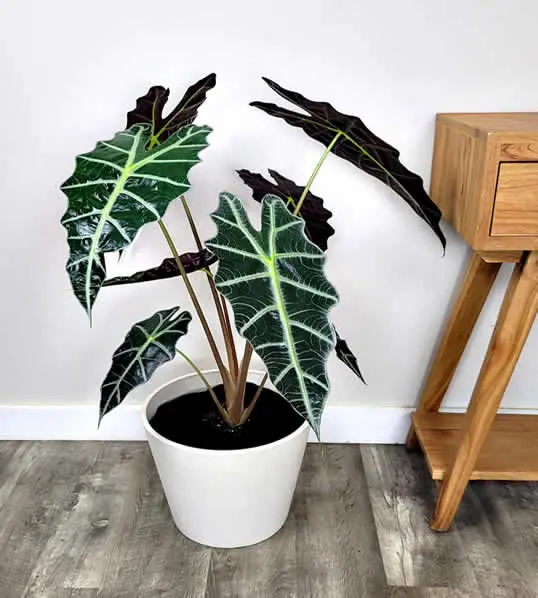
Quick Care Snapshot for Alocasia Amazonica
- Origin: A hybrid of Alocasia longiloba and Alocasia sanderiana (both from tropical Asia)
- Other Names: Alocasia Polly, African Mask Plant, Elephant Ear Plant
- Size: Up to 2 feet tall and wide
- Soil: Light, airy, and fast-draining
- Light: Bright, indirect light; avoid harsh direct sun
- Temperature: Prefers 65–80°F (18–27°C); avoid below 60°F
- Watering: Keep the soil evenly moist during the growing season, but ease up in winter
- Humidity: Likes it above 50%
- Fertilizing: Feed every 2–4 weeks in spring and summer using a diluted, balanced liquid fertilizer
- Propagation: Divide the rhizome in spring when repotting
A Closer Look at Its Origins
Let’s clear up the biggest myth first—Alocasia Amazonica isn’t from the Amazon!
It’s actually a man-made hybrid created in Miami during the 1950s by Salvadore Mauro, who named it after his nursery: Amazon Nursery.
Its parent plants, however, are tropical natives of Asia. So while the plant’s appearance may scream “jungle,” it’s more Florida than forest.
Standout Features of Alocasia Amazonica
What grabs attention is the deep green, arrow-shaped leaves with striking silver veins and ruffled edges.
Indoors, they rarely flower, but with leaves this dramatic, who needs blooms?
With good care, they grow up to 16 inches long, and the plant can spread to 1–2 feet in height and width.
Best Soil for Happy Roots
Alocasia Amazonica thrives in a light, fast-draining mix.
You want something that mimics the rich, decomposing forest floor—so avoid heavy soils that stay wet.
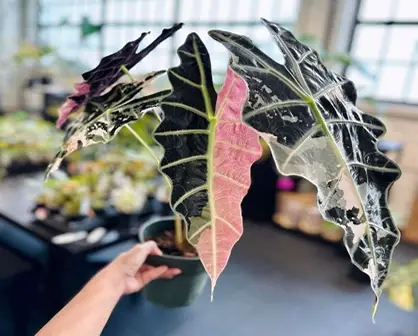
You can buy an aroid mix online (Etsy has great options), or make your own using:
25% fir bark
25% perlite
30% coconut coir
10% horticultural charcoal
10% worm castings
No matter the blend, make sure it’s airy and doesn’t hold too much water.
Light Preferences: Bright, But Not Harsh
This plant loves bright, indirect light. In cooler climates, it can even tolerate some direct morning sun.
However, too little light can cause fading leaf color and stunted growth.
A dim corner just won’t cut it!
Keep It Cozy: Ideal Temperature Range
To keep your Alocasia looking its best, maintain indoor temps between 65°F and 80°F.
If it gets too cold (under 55°F), the plant may go dormant and drop its leaves, though the bulb will likely survive and regrow in spring.
Avoid placing it near vents, as dry air can stress the plant.
Watering Routine: Keep It Moist, Not Wet
This plant likes consistent moisture—but soggy soil is a big no-no.
During the growing season, water when the top inch of soil begins to dry.
In winter, cut back on watering but don’t let it dry out completely.
Use your finger to check soil moisture, and aim for watering once or twice weekly during spring and summer.
In winter, once every 7–14 days should suffice.
Boosting Humidity for a Tropical Vibe
Alocasia Amazonica thrives in humidity over 50%.
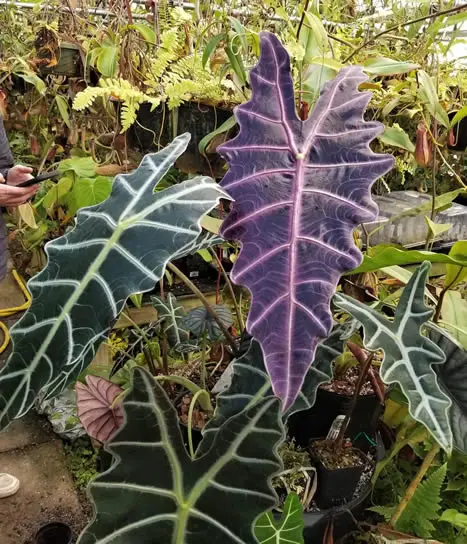
Luckily, creating a humid environment indoors is simple:
Place the pot on a pebble tray with water.
Mist the leaves with room-temperature water a couple of times a week.
Keep it in a bathroom with natural light for built-in humidity.
And again, avoid dry-air vents!
Feeding Time: What Fertilizer to Use
Feed your Alocasia every 2–4 weeks in the growing season with a balanced, water-soluble fertilizer at half strength.
Stop fertilizing in winter.
You can also opt for slow-release granules if your soil mix didn’t already include them.
And don’t forget to flush the soil every few months to prevent salt buildup—just run water through the soil for 5 minutes in the sink.
Do You Need to Prune?
Not really. Just snip off any damaged or dying leaves as needed.
Always use clean scissors or pruners to avoid spreading pests or diseases.
When (and How) to Repot
Only repot when your Alocasia outgrows its container or if the soil needs a refresh—usually every few years. Spring is the best time.
Use a pot just one size larger with proper drainage.
Carefully tease apart circling roots, settle the plant in fresh soil, water well, and place it back in its bright home.
Propagating Your Alocasia
You won’t get viable seeds from this hybrid, so propagation is done by dividing offsets (baby plants) during spring repotting.
Just gently separate them, ensuring each has roots, and plant them in their own containers.
How to Keep Those Gorgeous Leaves Clean
Dusty leaves don’t just look sad—they also block light and slow photosynthesis.
Skip the leaf shine products and try one of these methods instead:
Rinse the plant in the sink with lukewarm water.
Wipe leaves with a damp cloth.
Spray lightly with soapy water (¼ tsp mild dish soap per quart of water) and rinse.
And while you’re at it, give the pot a quick wipe-down too!
Watch for These Common Problems
Root Rot: The biggest threat. It happens when the soil stays soggy.
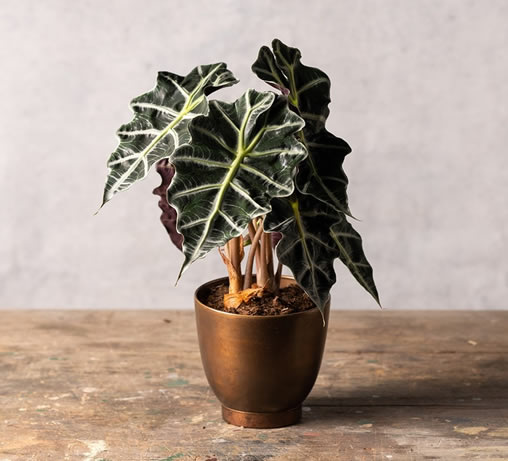
If the bulb or roots feel mushy and black, it’s often too late to save the plant.
Always use well-draining soil and let the top inch dry before watering.
Spider Mites: These sap-suckers leave yellow or brown specks and fine webbing.
Treat with neem oil or insecticidal soap, spraying both sides of the leaves.
Troubleshooting Yellow, Brown, or Droopy Leaves
Yellow Leaves: Too much or too little water.
Check drainage and water when the top soil feels dry.
Brown Edges: Not enough humidity or fertilizer salt buildup.
Mist regularly or flush the soil every few months.
Drooping Leaves: Usually a sign of low light or inconsistent watering.
Some yellowing and leaf loss is normal as the plant ages—just prune away old growth as needed.
Dormancy and Regrowth
If your Alocasia goes fully dormant in winter, don’t panic!
The bulb will bounce back in spring with fresh new leaves. Patience is key.
How Big Will It Get?
With good care, a mature Alocasia Amazonica reaches 1 to 2 feet in both height and width.
Is It Safe for Pets or Kids?
Nope—this one’s a look-don’t-touch kind of plant. It contains calcium oxalate crystals that are toxic if ingested and can also irritate skin.
Keep it out of reach of curious pets and little ones.
Related Articles
You may be interested in these other articles about Alocasia care:
Alocasia Plant Care: Indoor & Outdoor Care Guide
Alocasia Water Guide. Watering Alocasia & Growing Alocasia In Water
Understanding Alocasia Dormancy: What It Is, Why It Happens, and How to Handle It
Alocasia Dragon Scale Care Guide: How to Keep This Jewel Alocasia Thriving
Why Are My Alocasia Leaves Turning Yellow? Causes, Fixes, and What to Do Next
Why Is My Alocasia Drooping? Common Causes and How to Revive It
How to Keep Your Alocasia Wentii Thriving: Complete Care Guide
Alocasia Frydek Care Guide: How to Keep Your Green Velvet Thriving
Caring for Alocasia Zebrina: Tips for Thriving Stripes
How to Keep Your Alocasia Black Velvet Thriving: Complete Care Guide

